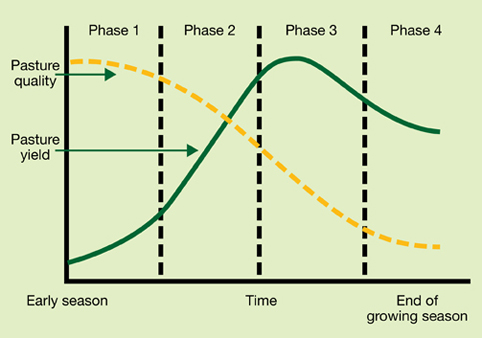Pasture growth
To maximise pasture production, it is important to understand the key factors affecting pasture growth.
Understanding pasture growth allows you to maximise pasture utilisation while also maintaining good land and pasture condition.
Phases of pasture growth
Pasture growth is usually described in three phases, followed by a fourth phase where pastures have 'hayed-off'.

Optimal pasture utilisation can be achieved through an understanding of the changes in pasture quality and yield (as shown above) as it ages through the phases. Animal production can be increased by grazing pastures during phases 1 and 2 as quality is high. Quantity can, however, be limiting during phases 1 and 2 and animal intake may be constrained.
As continued grazing in early phase 1 will slow pasture growth and limit production, it is important to moderate grazing during this period to assist subsequent growth.
Conversely, pastures in phase 3 will yield well but be of reduced quality.
Pasture composition
Improved pastures may be a monoculture (one species), but usually consist of a mix of species including annual and perennial grasses and legumes. In grazing improved pastures, it is important to be aware of the plant mix and the lifecycle of each species. Grazing strategies that preserve the species balance by avoiding grazing at critical growth stages such as at establishment and the reproductive stage for annuals, can then be adopted.
Pasture care
Overgrazing during critical growth periods such as early in phase 1, can deplete the plant reserves and root biomass of perennial species, reducing their persistence particularly during dry periods. Dry periods will also affect the growth of annuals, often reducing the growing season and with it the nutritional value of the pasture.
Stocking rates should be adjusted to match feed on offer as this changes with seasonal variations within years and between years. Plans should be put in place to respond to changing conditions and seasonal variability before pastures are overgrazed with potentially permanent effect.
Pasture rundown is the decline in pasture production over time. One of its characteristics is the removal of palatable species, particularly perennials, and the introduction of weeds. This is caused by overgrazing. Where weed infestation occurs, often after prolonged drought, herbicides may be used to restore the pasture balance. Whenever using chemicals, producers should be aware of any grazing withholding periods (WHP) and be sure to follow labelling directions.
Feeding the soil
Good pasture growth not only stabilises soil through root growth, but also promotes other favourable soil characteristics by increasing soil organic matter levels. This, in turn, increases water filtration and soil nutrients. Legumes will also contribute nitrogen to the soil, which promotes grass growth.
Improved pastures are typically more productive than the native pastures common to an area. This improved production is dependent upon factors such as soil fertility. Realising an improved pasture’s full potential usually requires the application of fertiliser.
Soil and plant tissue tests can help determine fertiliser requirements. Correct application timing is important and local advice from the government advisory department, a consultant or FertCare accredited fertiliser supplier can help determine the best application timing for the situation.


